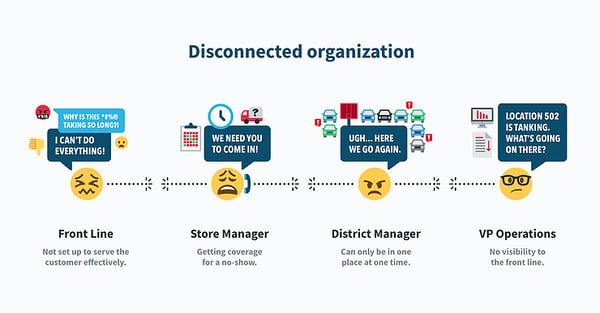4 signs of a disconnected organization - and 4 ways to fix that
by Sean Oliver, on July 30, 2019
There’s no doubt that it’s a tough time to run a services business. Consumer demands are growing every day, while unemployment is low and employee turnover is high. If you want to form lasting connections with your customers, you first need to connect and engage with your workforce. That’s not as simple as it sounds, especially for multi-unit leaders who can’t visit every geographical location each day, and typically work different hours than many of their team members. This is why so many operators struggle with managing disconnected organizations.
Common challenges of a disconnected organization
There are four overarching issues that tend to plague most dispersed companies, each of which can have a severely negative impact on both your top line and bottom line, if not addressed.
1. Lack of alignment with and across teams
Above-store leaders can only be in one place at a time, so it’s nearly impossible to keep multiple units and teams on the same page or get your finger on the pulse of employee sentiment. And think of this from your staff’s point of view. Feeling disconnected from the rest of the organization can be extra frustrating for a frontline worker who’s put on the spot by a customer but doesn’t have the tools or information they need to succeed.
2. Inconsistent service and staffing levels
When your company goals are ambiguous or shared only sporadically, store-level performance and focus varies. But if you’re only alerted to issues after they’ve already impacted service metrics, there’s less you can do to address underlying operational problems from the district level.
Compounding this, general managers who aren’t tightly in sync with their workers (many of whom are juggling multiple part-time jobs, along with school schedules, etc.) face big scheduling challenges. If an employee doesn’t show up for their shift, the manager gets pulled off the floor to find coverage on-the-fly, which puts pressure on the team, and ultimately results in a poor customer experience.
3. High rates of employee turnover
In many parts of the U.S., talent markets are fiercely competitive, particularly in food service, retail, and hospitality. In fact, the restaurants and accommodations sector faces a whopping 75% turnover rate - and sometimes, even higher than that. This employee retention problem is heightened in scattered organizations where frontline workers often don’t feel adequately recognized — making them twice as likely to say they'll quit in the next year, according to Gallup.
4. Disengaged, disjointed attitudes
Even if your business started out with a tight-knit ‘mom and pop’ vibe, this culture may not feel sustainable as you add new locations further afield. Especially when you rely on a seasonal workforce, leaders of disconnected organizations often fail to notice the us-vs-them mentality that can fester and detract from employee engagement levels.
How to effectively connect teams through communications
Thankfully, there are simple ways you can tackle these challenges head-on to reap the benefits of a more connected organization. The key is to find the optimal cadence, content, and style for communications with your entire workforce. If you make this part of everyone’s edict and general mindset, you’ll achieve real business impact.
1. Build tight connections for organization-wide alignment
Make sure every level of management has easy ways to stay connected with each other, and with each one of their locations. This will allow district and general managers to cascade information consistently and exchange useful best practices in real time. Facilitate intentional connections between operations executives and frontline teams, so you can better anticipate issues before they become problems, and provide the guidance and support your stores require.
2. Boost operational performance through better prioritization and scheduling
Constantly and consistently communicate your company and service goals to establish a culture of operational excellence. When you share performance metrics directly with the front line, they’ll feel a sense of ownership and clarity around what and how to improve.
Also consider adopting mobile scheduling tools, so everybody knows who’s working when (without having to call or come into the store), and can quickly get in touch to swap shifts when needed. This empowers the front line to take shift coverage into their own hands and will help managers ensure optimal staffing levels, without a heavy lift on their part.
3. Increase engagement to decrease turnover
While reducing turnover can feel like a daunting task, there are always steps you can take to move the needle on team engagement. Show recognition for employees, and they’ll be more likely to stick around (or boomerang back to your company the next time they’re looking for a seasonal job). Ensure every level of the organization makes the effort to highlight and reinforce positive behaviors in a public forum, so people feel appreciated.
4. Nurture a unified organizational culture
Don’t forget to explicitly celebrate how each key win reflects your company’s values. You can also make it easier for staff to broaden relationships beyond the teams they work with on their regular shifts. As people interact across the organization on a personal level — sharing photos, birthday wishes, and other fun messages — everyone will become more connected. This fosters a cohesive culture where every single employee (from your front line, to kitchen staff, to the back office) feels pride over a job well done.
Don’t let team communication and connections remain an afterthought. Try Crew, a mobile app that helps you connect the front line to your entire organization, engage directly with your teams, and share the critical information they need to do their jobs as best they can.


